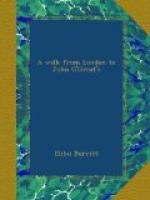One of the principal advantages Mr. Jonas realises in cultivating such an extent of territory, is the ability to economise his working forces, of man, beast, and agricultural machinery. He saves what may be called the superfluous fractions, which small farmers frequently lose. For instance, a man with only fifty acres would need a pair of stout horses, a plough, cart, and all the other implements necessary for the growth and gathering of the usual crops. Now, Mr. Jonas has proved by experience, that, in cultivating his great occupation, the average force of two and a quarter horses is sufficient for a hundred acres. Here is a saving of almost one half the expense of horse-force per acre which the small farmer incurs, and full one half of the use of carts, ploughs, and other implements. The whole number of horses employed is about seventy-six; and the number of men and boys about a hundred. The whole of this great force is directed by Mr. Jonas and his sons with as much apparent ease and equanimity as the captain of a Cunarder would manifest in guiding a steamship across the Atlantic. The helm and ropes of the establishment obey the motion of one mind with the same readiness and harmony.
A fact or two may serve an American farmer as a tangible measure whereby to estimate the extent of the operations thus conducted by one man. To come up to the standard of scientific and successful agriculture in England, it is deemed requisite that a tenant farmer, on renting an occupation, should have capital sufficient to invest 10 pounds, or $50, per acre in stocking it with cattle, sheep, horses, farming implements, fertilisers, etc. Mr. Jonas, beyond a doubt, invests capital after this ratio upon the estate he tills. If so, then the total amount appropriated to the land which he rents cannot be less than 30,000 pounds, or nearly $150,000. The inventory of his live stock, taken at last Michaelmas, resulted in these figures:—Sheep, 6,581 pounds; horses, 2,487 pounds; bullocks, 2,218 pounds; pigs, 452 pounds; making a grand total of 11,638 pounds. Every animal bred on the estate is fatted, but by no means with the grain and roots grown upon it. The outlay for oil-cake and corn purchased for feeding, amounts to about 4,000 pounds per annum. Another heavy expenditure is about 1,700 pounds yearly for artificial fertilisers, consisting of guano and blood-manure. Mr. Jonas is one of the directors of the company formed for the manufacture of the latter.
The whole income of this establishment is realised from two sources--meat and grain. And this is the distinguishing characteristic of English farming generally. Not a pound of hay, straw, or roots is sold off the estate. Indeed, this is usually prohibited by the conditions of the contract with the landlord. So completely has Mr. Jonas adhered to this rule, that he could not give me the market price of hay, straw, or turnips per ton, as he had




